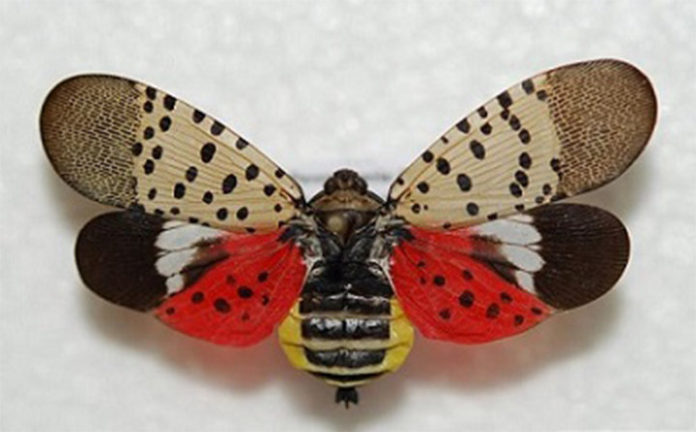Since you cannot work in the garden yet, it is a good time to do your garden research.
One important topic to brush up on is the threat of invasive species. Invasive species are organisms (plants, animals, and pathogens) that are not native to our ecosystem and whose introduction causes economic or environmental harm, or harm to human health. Invasives can be spread via many activities such as boating, hiking, fishing, and even swimming. Seeds, plants, and insects can attach to boots, waders, clothing, cars, or boats. Even internet sales, passenger baggage, and transporting certain items such as firewood can spread invasive species.
A new and dangerous invasive threat is the spotted lanternfly (SLF), Lycorma delicatula, which has most recently been found in Ithaca — just off the Cornell University campus.
With New York State’s important Finger Lakes grape-growing region and wine industries so close to Ithaca, state agencies are especially concerned about this insect’s impact on the region.
What is it?
The SLF is not a fly but is a large plant-hopper, native to Asia. In the U.S., it was first found in Pennsylvania and has begun to spread to neighboring states.
It feeds on tree of heaven (ailanthus altissima); but what is concerning is that is also feeds on a wide variety of agricultural crops such as grapevines, hops, apples, blueberries, and stone fruits.
The insect could also impact our forests since it can feed on hardwoods such as walnut and maple trees.
What do they look like?
These insects are quite colorful. Nymphs are black with white spots; they turn red before changing into adults. Nymphs can be seen as early as April. Adults begin to appear in July; they are about an inch long and are very eye-catching. In fact, with their colors and broad wings, they can be mistaken for butterflies.
In the fall, adults lay eggs on just about any hard surface including tree trunks, rocks, tables, and even vehicles.
Adults secrete a sticky substance called honeydew; since the adults can congregate in large numbers, this sticky substance can be a major nuisance as it can get in your hair, on clothes, or other objects.
How they spread
These insects can jump and fly short distances. However, the main way they have spread is via human activity; since their eggs can be laid on so many surfaces, they can hitch a ride simply by the movement of things like vehicles, firewood, and even transporting items such as patio furniture.
Learn how to identify SLF by visiting the New York State Integrated Pest Management website at www.nysipm.cornell.edu. On the main page, you will see a quick link to SLF. There is an excellent fact sheet giving you more information.
New York has implemented a quarantine checklist including specific items being transported into the state from infested locations. What to do if you find SLF is also included. In addition to New York State’s IPM website, the Penn State Extension service has a website dedicated to SLF. There are also several videos you can watch. Visit the website at extension.psu.edu/spotted-lanternfly.
Learn how to identify egg masses
These egg masses can survive our winter and hatch into nymphs in the spring. The best time to find and destroy egg masses is winter through early spring. The websites provided will show you how to identify egg masses and how to remove them. Any hard surface such as firewood, picnic tables, even vehicles can be a site for egg masses.
If you suspect SLF egg masses or if you believe you have located the insects, be sure to notify the Department of Environmental Conservation via email to spottedlanternfly@dec.ny.gov.
Find more gardening information on our website, cceoneida.com, clicking on Home & Garden on the menu or call us at 315-736-3394, ext 100. Be sure to like us on Facebook (www.facebook.com/cceoneida) and check out our YouTube channel (www.youtube.com/user/cceoneida) for great gardening talks.
Credit: Source link































